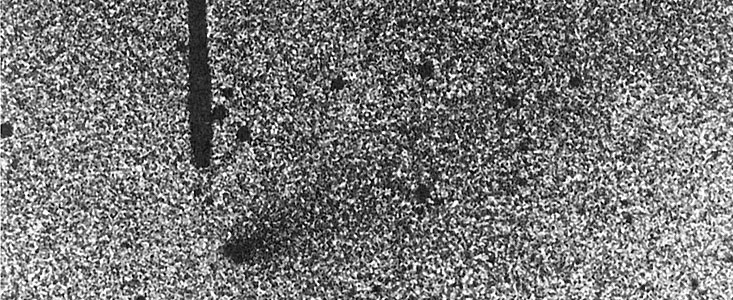Press Release
First Picture of New Periodic Comet West-Hartley
30 May 1989
On May 11, 1989, Richard M. West at the ESO Headquarters in Garching, Fed.Rep.Germany, found a new comet in a photographic plate obtained on March 14 by night assistant Guido Pizarro with the 1-m Schmidt at the ESO La Silla Observatory. The blue-sensitive plate was exposed during 60 minutes and was centered in the southern constellation of Libra.
This "negative'' photo is a reproduction from that plate. The comet's head (lower left) of magnitude 17.5 is seen as a condensation in a diffuse halo. Due to the comet's motion during the exposure, it appears as a short trail. A very faint, broad tail stretches across the picture. The round images are stars in our galaxy. The dark, vertical line in the upper left part is an artificial edge mark on the plate. The picture measures 7.9 x 6.4 arcminutes square and North is up and East is to the left.
Since only a single plate was available, it was not possible to determine with certainty whether the direction of the motion was North-East or South-West. The failure to find the comet on a plate taken in late April with the U.K. Schmidt at the Siding Spring Observatory, Australia, at first seemed to indicate that the South-West possibility was less probable.
However, on May 28 Malcolm Hartley accidentally discovered a comet on a survey plate taken by S. M. Hughes with the U.K. Schmidt, about 15° West-South-West of the sky field shown on the photo. It was quickly realized that this object was identical with the comet seen earlier by West. A preliminary orbital computation by Brian Marsden of the IAU Central Bureau for Astronomical Telegrams indicated that it moves in an elliptical orbit with a period of about 6.6 years. It passed its perihelion (the point nearest to the Sun) in early October 1988 at a distance of about 360 million kilometres.
According to astronomical custom it was named after the two astronomers who discovered it independently. It has also received the preliminary designation "1989k'', indicating that it is the eleventh comet which was discovered or recovered since the beginning of this year.
From the preliminary orbit it is now known that the comet was about 280 million kilometres distant from the Earth when this photo was obtained. The projected tail length was about 4 arcminutes, or 300 000 kilometres.
Contacts
Richard West
ESO
Garching, Germany
Tel: +49 89 3200 6276
Email: information@eso.org
About the Release
| Release No.: | eso8905 |
| Legacy ID: | Photo 01/89 |
| Name: | 123P/West-Hartley Comet |
| Type: | Solar System : Interplanetary Body : Comet |
| Facility: | ESO 1-metre Schmidt telescope |

